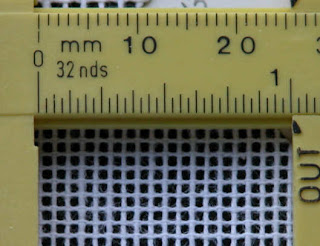There are basically three types of needlepoint canvases - then each comes in many sizes ( holes per inch ).
 |
| Needlepoint Canvases © 2013 JAN VOICH DESIGNS |
Above - you see MONO - INTERLOCK - and PENELOPE canvases
 |
| 18 mesh - interlock - needlepoint canvas |
 |
| 10 mesh - mono - needlepoint canvas © 2013 JAN VOICH DESIGNS |
The sizes are according to how many holes there are per inch - seen as hpi - or mesh - also called count.
These vary from 3 hpi - 24 hpi - depending on the project.
To learn more - visit this link - NEEDLEPOINT CANVASES
In this manner - painting each picture is extremely expensive and the colors are quite limited.
Each color has to be separated - and a positive is then made.
Then you begin with a square metal or wooden frame the size of the finished design - plus four inches around the actual design area.
These vary from 3 hpi - 24 hpi - depending on the project.
To learn more - visit this link - NEEDLEPOINT CANVASES
How to Paint Needlepoint Canvases
Painting needlepoint canvases has many techniques. We cover all possiblities within these pages.Silk Screening Designs onto Needlepoint Canvases
The most common use to be silk screening the designs.In this manner - painting each picture is extremely expensive and the colors are quite limited.
Each color has to be separated - and a positive is then made.
Then you begin with a square metal or wooden frame the size of the finished design - plus four inches around the actual design area.
Over this frame you tightly stretch a piece of sheer fabric (originally silk - now polyester).
This is the screen.
This is the screen.
Over this sheer fabric you put a thin sheet of plastic into which you have cut holes where you want ink to appear on the canvas.
You can either cut the holes with a scalpel (an arduous task), or you can use a liquid plastic coating that's sensitive to ultraviolet light and burn or cut the holes with light.
Next, you place the blank canvas on a flat board and press the screen onto the fabric.
By coating the screen with thick ink using a sponge - or better - a special squeegee - you cause the ink to flow through the screen onto the needlepoint canvas.
You can either cut the holes with a scalpel (an arduous task), or you can use a liquid plastic coating that's sensitive to ultraviolet light and burn or cut the holes with light.
Next, you place the blank canvas on a flat board and press the screen onto the fabric.
By coating the screen with thick ink using a sponge - or better - a special squeegee - you cause the ink to flow through the screen onto the needlepoint canvas.
For multi-color designs, you do this multiple times, starting with the lightest color and moving up to the darkest.
Each color must match exactly - then the design is finished.
Problems arise if the design is linear - symmetrical -- as the blank canvas is not always perfectly square - thus -- even a millimeter of movement will cause problems.
Visit the link below for more exact explanations about screen printing:
http://www.printcutsew.com/259/the-beginners-guide-to-sounding-like-a-screen-print-pro/
Each color must match exactly - then the design is finished.
Problems arise if the design is linear - symmetrical -- as the blank canvas is not always perfectly square - thus -- even a millimeter of movement will cause problems.
Visit the link below for more exact explanations about screen printing:
http://www.printcutsew.com/259/the-beginners-guide-to-sounding-like-a-screen-print-pro/
Transfer Needlepoint Designs onto Canvases
The alternative is to use iron-on transfers. The design is created with thin thermoplastic inks on a paper backing. By heating the design, you bond it to the fabric of the canvas.Hand Painted Needlepoint Canvases
Hand painting the designs onto canvas is another technique.
This sounds simple enough - however - a large stitch-painted canvas with many colors can drive you to the edge of hysteria - so stick to small two inch designs if you want to paint it yourself.
http://blog.asmarainc.com/blog/bid/57805/How-Needlepoint-Rugs-are-Handmade-Using-a-Painted-Needlepoint-Canvas
If you should want the challenge - make your own paint - using pigments and additives: linseed oil - egg yolks - depending on the colors and effects you desire.
This sounds simple enough - however - a large stitch-painted canvas with many colors can drive you to the edge of hysteria - so stick to small two inch designs if you want to paint it yourself.
http://blog.asmarainc.com/blog/bid/57805/How-Needlepoint-Rugs-are-Handmade-Using-a-Painted-Needlepoint-Canvas
If you should want the challenge - make your own paint - using pigments and additives: linseed oil - egg yolks - depending on the colors and effects you desire.


No comments:
Post a Comment